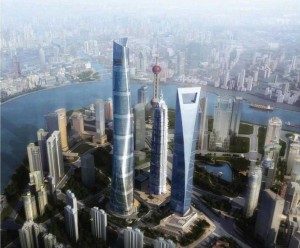By C. J. Hughes www.archrecord.construction.com
Despite the economic downturn, supertall towers continue to rise. Of the top 10 now in progress, six were designed by U.S. firms. Only one, however, is on American soil.

As might be expected during a prolonged downturn, plans for huge new record-setting skyscrapers have been delayed or flat-out scrapped, from the 91-story Dubai Towers in Qatar to the 84-story Faros de Panama in Panama. Here in the United States, Santiago Calatrava’s Chicago Spire, which at 2,000 feet was to be the world’s tallest apartment building, was nixed last year.
But despite ongoing global economic woes, many “supertalls,” which stretch at least 1,350 feet (about the Empire State Building’s height), are chugging along and seem poised to be completed on schedule, according to the Council on Tall Buildings and Urban Habitat, which keeps tabs on them.
“In many cases, it’s about sheer need for housing,” says Antony Wood, executive director of the Chicago-based organization, of the supertall phenomenon. He adds that these towers are, for the most part, cropping up in Asia.
Indeed, five of the top 10 supertalls now under construction are located in China. Just one, One World Trade Center, has an American address. Of course, that doesn’t mean Americans aren’t benefitting: Six of the 10 supertalls were designed by domestic firms.
Among the soaring Chinese edifices is the 128-story Shanghai Tower from Gensler, which is on track to be the world’s second-tallest building when completed in 2014. Only Burj Khalifa in Dubai, which has 163 stories, is taller. In early December, 10 floors of the Shanghai Tower, which will have galleries, offices and hotel rooms, had been completed, says Dan Winey, a Gensler managing principal. As for its twisting form, “we wanted it to look like it’s emerging from the ground, a symbol of China’s future,” he says.
While China isn’t known for its strict environmental controls, many of its supertalls are being touted as being remarkably green. The Shanghai Tower, for instance, will draw power from wind turbines and store rainwater. It will be strikingly energy-efficient, using just 65 percent of the energy of a conventional office building, according to Winey.
Kohn Pedersen Fox Associates (KPF) also has been busy overseas, as two of the 10 ultra towers on the council’s list were designed by the New York-based firm.
In Guangzhou, the firm’s 116-story Chow Tai Fook Centre will have setbacks that help differentiate between offices, hotels, and apartments. The terracotta-and-glass tower will sit atop three planned subway lines and also have a tunnel connecting to an existing commuter rail line that whisks people between cities on the Pearl River. “There will be 25,000 people in the building daily, and 80 to 90 percent will arrive by train or bus,” says Forth Bagley, a KPF principal.
Tied to the same rail system, in nearby Shenzhen, is KPF’s Ping An International Finance Center, a 115-story office tower. Like many supertalls, the dart-like Ping An has a narrow, faceted top, which is intended to lessen sway from wind, says David Malott, the project’s design director. Excavation ended in November 2010, and floors are scheduled to start rising this fall. Completion is slated for 2015.
A mix of homes and businesses may be the best way to make the economics of a supertall work, as developers have to be creative about filling all that space. Yet Dubai’s Pentominium, from Davis Brody Bond Aedas, will only have condos — 172 of them.
While many Dubai projects sputtered when the recession began, Pentominium has persevered. In early December, four of its 122 floors were out of the ground, says Andrew Bromberg, the firm’s international design director, adding that the tower will be the tallest residential building in the world when finished in 2013.
While China’s supertalls may be fueled by swelling populations, the Mideast’s versions stem more from the desire to forge national identities, says Gary Haney, a partner in the New York office of Skidmore Owings & Merrill.
His firm’s 77-story Al Hamra Firdous Tower is set to open in Kuwait City in March. City officials relaxed a 40-story height cap to allow the limestone-and-tile-clad building to proceed. “Tall buildings tend to be an expression of civic pride, that a place has arrived,” Haney says, citing New York in the 1930s and Chicago in the 1970s.
The largest of the planned supertalls is, paradoxically, the one most shrouded in mystery: the India Tower of Mumbai, designed by Norman Foster. The CTBUH calculates its planned height as 2,362 feet, though a spokeswoman for Foster + Partners said she couldn’t discuss dimensions.
If the economy nosedives further, some of these projects could be canceled. Then again, analysts say, others now in the blueprint stage seem to have legs, like RMJM’s Okhta Centre, with 77 stories, in St. Petersburg, and Pelli Clarke Pelli’s 15 Penn Plaza, with 68, in New York. Wood thinks his skyscraper-centric Chicago hasn’t heard the last of Calatrava’s Spire, either. “I wouldn’t rule it out just yet,” he says.
World’s Tallest Buildings Under Construction
- India Tower; Mumbai; 2,362 feet, 125 floors; Foster and Partners
- Ping An International Finance Center Tower 1; Shenzhen; 2,165 feet, 115 floors; Kohn Pedersen Fox (KPF)
- Shanghai Tower; Shanghai; 2,074 feet, 128 floors; Gensler
- Makkah Royal Clock Tower Hotel; Makkah, Saudia Arabia; 1,972 feet, 95 floors; Dar Al-Handasah Architects
- Goldin Finance 117; Tianjin; 1,959 feet, 117 floors; P&T Group
- Doha Convention Center Tower; Doha; 1,808 feet, 112 floors; Murphy/Jahn
- One World Trade Center; NYC; 1,776 feet, 105 floors; David Childs/SOM
- Chow Tai Fook Centre; Guangzhou; 1,739 feet, 116 floors; KPF
- Dalian Greenland Center; Dalian, China; 1,699 feet, 108 floors; HOK
- Pentominium; Dubai; 1,692 feet, 122 floors; Aedas
- Burj Al Alam; Dubai; 1,673 feet, 108 floors; Nikken Sekkei
- Qatar National Bank Tower; Doha; 1,673 feet, 101 floors; KEO/Peddle Thorp Architects
Information provided by the CTBUH












